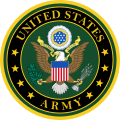Fourth Army (II)
The second iteration of the headquarters, Fourth Army, was constituted in the Regular Army on 9 August 1932 and allotted to the Seventh Corps Area. The headquarters was organized on 15 August 1932 at Omaha, Nebraska. The Headquarters Company (constituted in the Organized Reserve on 15 October 1921) was withdrawn from the Organized Reserve 18 August 1933, and allotted to the Regular Army effective 1 October 1933.
Due to the abandonment in 1933 of the “Six Army” plan in favor of the “Four Army” plan, the Fourth Army area was restructured to consist of the Seventh and Ninth Corps Areas. The army headquarters was transferred to the Presidio of San Francisco on 3 October 1933 upon the assumption of command of Major General Malin Craig, the senior corps area commander. The Fourth Army mission was to develop defense and operational plans for contingencies in the vicinity of the Pacific coast and the western United States, review the
mobilization plans of the Seventh and Ninth Corps Areas, and oversee the training of units in the army area. As part of the responsibility to oversee training, the Fourth Army planned, conducted, and/or participated in three major maneuvers between 1937 and 1941.
The 1937 maneuvers, under the command of Major General George S. Simonds, were actually four separate exercises and were held at Fort Riley, Kansas, and Camp Ripley, Minnesota, for the Seventh Corps Area troops, and at Camp San Luis Obispo, California, and Fort Lewis, Washington, for the Ninth Corps Area troops. The next Fourth Army maneuver was also a split exercise, this time under the command of Lieutenant General John L. DeWitt. Held in August 1940, the maneuver was conducted near Camp Ripley for the Seventh Corps Area units and at Fort Lewis for the Ninth Corps Area contingent. A primary focus of this exercise was to train the army and corps staffs, all of which had been provisionally organized from the corps area staffs. Following the 1940 maneuver, the organization of the Fourth Army was changed to reflect the assignment of the III Corps to the troop list and the loss of the VII Corps to the Second Army. The Fourth Army Headquarters Company was activated on 18 November 1940 at the Presidio of San Francisco. The final maneuver in which the Fourth Army participated prior to World War II was the GHQ Fourth Army maneuvers in southwestern Washington in August and September 1941. The exercise included over 120,000 Fourth Army soldiers from Regular Army and National Guard units. Following the maneuvers, the Fourth Army headquarters returned to its station at the Presidio of San Francisco, where it was located on 7 December 1941. [3]



